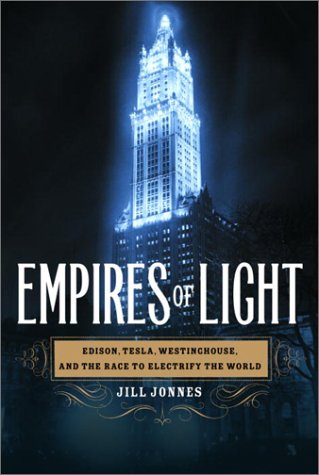
Empires of Light
Edison, Tesla, Westinghouse, and the Race to Electrify the World
کتاب های مرتبط
- اطلاعات
- نقد و بررسی
- دیدگاه کاربران
نقد و بررسی

May 5, 2003
Jonnes, a historian at Johns Hopkins (We're Still Here; Hep-Cats, Narcs and Pipe Dreams), details the rise and fall of the three visionaries who harnessed electricity, while also offering a critique of corporate greed. Her tale emphasizes the "War of the Electric Currents," in which Thomas Edison sought to defend the primacy of his direct current electrical system against George Westinghouse's higher-voltage and more broadly applicable alternating current system. Nikola Tesla, the somewhat kooky Serbian genius (and former Edison man), joined the fray on Westinghouse's side with his AC induction motor. Jonnes serves up plenty of color in an engaging and relaxed style, detailing how Edison capitalized on the "deaths by wire," or accidental electrocutions, from the AC system, sensationalized in the newspapers of the time. As she shows, Edison's "holy war" led to Westinghouse's AC being used in the first prison execution by electric chair, in 1890—which proved considerably more grisly and less humane than originally billed. For Jonnes, this history culminates neatly in a rather trite moral lesson: that corporate greed is bad. She contrasts it with the three public-minded men sketched here, who embody what Jonnes believes capitalism ought to be. Edison wanted only "the perfect workshop"; Westinghouse was interested "in helping the world" and giving his workers disability benefits; Tesla wanted to "liberate the world from drudgery." Jonnes's titans loom as monumentally as the allegorical Good Capitalists in an Ayn Rand melodrama. For those who view history as less tidy, this may strain the patience at times. 16 pages of photos not seen by PW. (On sale Aug. 19)FYI:Much of this story was covered, with more emphasis on the first execution by electric chair, in Richard Moran's
Executioner's Current: Thomas Edison, George Westinghouse, and the Invention of the Electric Chair, published last October.

June 1, 2003
The study and awareness of electricity is not new, but the successful control and use of it is relatively recent. Jonnes begins by detailing the study of electrical phenomena from ancient times up through the Enlightenment. Audiences who are familiar mostly with Thomas Edison and the lightbulb will find the earlier, less-told part of the story a welcome addition to their knowledge. Naturally, Edison has his place, too, and Jonnes fills a number of pages with the accomplishments of the three major inventors (Tesla, Westinghouse, and Edison), starting with their early research and progressing into the practical application of their work. The last part of the book deals with the slow process of bringing electricity to the rest of the country, the industrial wars between the rival electric firms, and the fates of those who played a role in the electric revolution. A very accessible and informative historical account that will be fascinating reading for a general audience as well as those with a more specialized interest.(Reprinted with permission of Booklist, copyright 2003, American Library Association.)

























دیدگاه کاربران